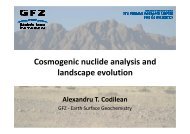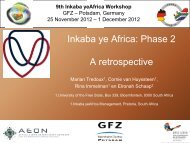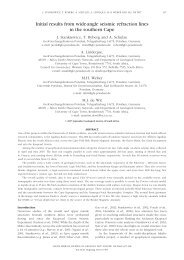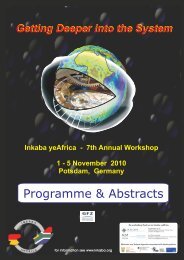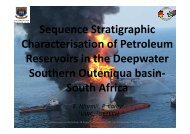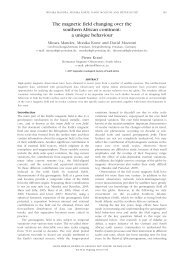South Africa - Inkaba.org
South Africa - Inkaba.org
South Africa - Inkaba.org
You also want an ePaper? Increase the reach of your titles
YUMPU automatically turns print PDFs into web optimized ePapers that Google loves.
A Lunar Geotechnical GIS as an aid for exploration and<br />
settlement construction<br />
Leon Croucamp 1, Ludwig Combrinck 2, Marius de Wet 3<br />
1. University of Stellenbosch, <strong>South</strong> <strong>Africa</strong>, lcroukamp@sun.ac.za<br />
2. HartRAO, <strong>South</strong> <strong>Africa</strong>, ludwig@hartrao.ac.za<br />
3. University of Stellenbosch, <strong>South</strong> <strong>Africa</strong>, mdw1@sun.ac.za<br />
ABSTRACT<br />
We present the case for a Lunar Geotechnical GIS and the Earth based methods and instruments required to<br />
support a geo-referenced framework for such a GIS.<br />
During discussions with various role-players (NASA/ESA/etc) it was determined that the Lunar community have<br />
the need for a Lunar GIS system as well as a Space Geodesy system to create a single world-wide (lunar-wide)<br />
geo-referenced framework for the moon. Initially the biggest user of such a system would be the Constellation<br />
Programme (CxP) of NASA plus other space faring nations of the world who are currently undertaking satellite<br />
missions to the moon and are planning future missions. The Moon will eventually become a springboard for future<br />
missions to Mars and beyond, in addition it will play a significant role as laboratory for the determination and<br />
creation of better technologies for space travel and space material manufacturing.<br />
A new space geodesy site is being developed at Matjiesfontein and will be known as the Matjiesfontein<br />
Observatory (MO). This observatory will house the various Satellite Laser Ranging and Lunar Laser Ranging<br />
instruments to track the GPS/GNSS/GALILEO type systems placed in orbit around the earth. Tracking of orbiters<br />
around the moon (such as Lunar Reconnaissance Orbiter) and interplanetary probes will also be supported. The<br />
most recent launch of a satellite to the moon was on Friday 1 October 2010 by China. The ability to track these<br />
satellites accurately is vital to create a geo-referenced framework for the correct referencing of any data collected<br />
on the moon, be it geotechnical, geochemical or other.<br />
KEYWORDS: GIS, Geotechnical, Lunar, Space Geodesy<br />
20



